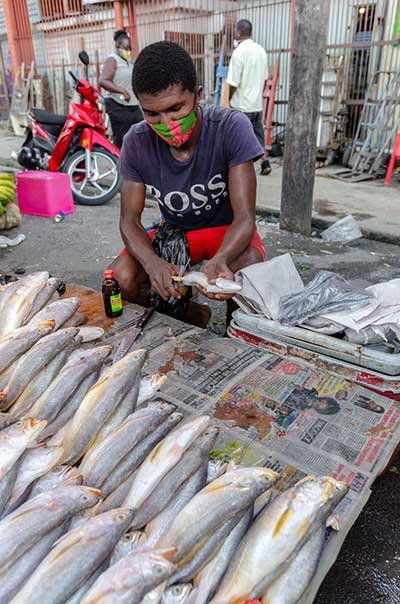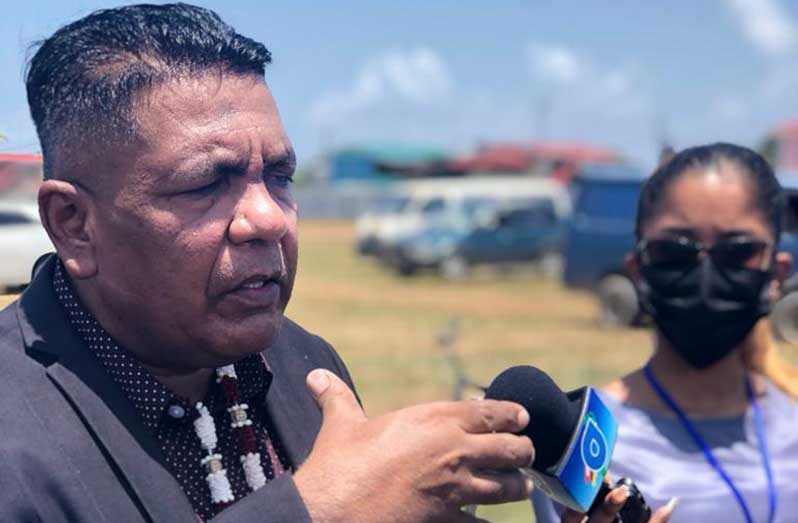BY 2025, the Ministry of Agriculture is looking to double the country’s fish production by comprehensively and sustainably developing the aquaculture industry.
This is according to subject minister, Zulfikar Mustapha, who was, at the time, engaging the Japanese Ambassador to Guyana and Trinidad and Tobago, Tatsuo Hirayama.

At his Regent Street, Georgetown Office, on Tuesday, Minister Mustapha informed the visiting ambassador that since the People’s Progressive Party/Civic (PPP/C) was elected to office, a lot more effort has been placed on ensuring sustainable fishing practices are employed so that the country’s stock could be sustained and eventually increased over time.
He also underscored the importance of pursuing sustainable fishing, against the backdrop of climate change, which has resulted in a noticeable depletion of fish stocks.
Recognising Japan to be a nation with many aquaculture successes, Minister Mustapha expressed hope that the Japanese government could assist Guyana by providing technical support to further develop Guyana’s aquaculture industry.
Ambassador Hirayama in turn said that he was pleased with the government’s emphasis on agriculture in Guyana, and underscored the importance for countries to manage their fishing resources in a sustainable manner.
Despite the climate change challenges, Guyana’s aquaculture industry continues to do well and maintains a high level of resilience. As a matter of fact, during the first half of 2021 alone, exports for the fisheries sector surpassed $4 billion.
The figures, previously provided by Minister Mustapha, show that during the first six months of the year, the fisheries industry netted some $27 million in revenue.
To further improve the sector’s earning capacity, the Ministry of Agriculture embarked on a series of initiatives, including the reviewing and updating of the country’s Inland Fisheries and Aquaculture Strategy (2021-2026); the resuscitation of the National Fisherfolk Organisation; the development of a fishing vessel inspection programme; and, more importantly, the training of sector officials who can further train local fisherfolk.
Only recently, Minister Mustapha engaged the United States Economic Affairs Department to address some of the challenges faced by the players within the local fishing industry.
The Agriculture Minister had also informed the government’s Department of Public Information that he had been tasked with identifying focal points that could be discussed at a more technical level with the US officials.
“We will be meeting almost on a monthly or bi-monthly basis to deal with these issues. But these are very important trade issues for us,” Mustapha said.
Las year, even without outside assistance, the fisheries sector managed to secure revenue in excess of $16 billion, while aquaculture mustered $207,251,016.
According to the Food and Agriculture Organisation of the United Nations (FAO), in Guyana, “capture fisheries” is undertaken by artisanal fishers and by an industrial fishing fleet composed of trawlers and hand-liners, including some foreign flagged, licensed vessels.
The organisation said most of Guyana’s fishing effort occurs in the relatively shallow waters of the continental shelf. In 2017, the estimated fleet comprised an estimated 1,498 vessels ranging in size from six to 24 metres, of which the great majority (83 per cent) were gill netters.
Aquaculture, on the other hand, has been practised for many years using mostly “low-input culture method” in brackish water and freshwater ponds, employing cachama, tilapia, and whiteleg shrimp as the major target species.
MAJOR CONTRIBUTOR
The consolidated contribution of both aspects of this industry accounted for two per cent of Guyana’s overall Gross Domestic Product (GDP) and 12 per cent of the agricultural GDP in 2020.
Information shared with the Guyana Chronicle shows that production in the area of marine fisheries was just over 30,000 metric tonnes at the end of November 2020, but was projected to end the year at over 35,000 metric tonnes. Total production was just above 38,000 metric tonnes in 2019.
Also, last year, Guyana produced finfish (artisanal), finfish (industrial), red snapper, prawns, seabob (industrial), whitebelly, seabob (artisanal) and tuna. Of those varieties, finfish raked over $11 billion — the most revenue for this industry — while red snapper and seabob each earned stakeholders over $1 billion.
Production in the aquaculture sector, up to November last year, was 121,741 kilograms, but was projected to end the year at 137,626 kilograms. Total production was just above 246,919 kilograms in 2019. This sub-sector produces bashaw, black shrimps, hassar, mullet, querriman, tambaqui and tilapia.
The aquaculture sector in Guyana is still relatively small, with production occupying only about 350 hectares of land around the country. But efforts are still ongoing to make the sector globally competitive and a key contributor to economic growth.
This is being realised through several initiatives such as the expansion of the Satyadeow Sawh Aquaculture Station, and aquaculture zoning – both on land and in water.
Aquaculture is the process of rearing, breeding and harvesting of aquatic species, both animals and plants, in controlled aquatic environments like the oceans, lakes, rivers, ponds and streams.
“Aquaculture in Guyana shows strong potential since the country has relatively large acres of flat lands with suitable soil types and access to large quantities and good quality freshwater (water conservancies)… moreso there are existing drainage and irrigation infrastructure in some areas, sub-tropical temperatures for shrimp and fish production and good availability of agricultural/ fisheries by-products for the formulation and manufacturing of aqua feed,” Minister Mustapha said in a recent report.
The FAO had already provided US$100,000 to Guyana in 2019, to strengthen the strategic and regulatory framework for inland fisheries and aquaculture development in Guyana.
The fisheries department, in collaboration with the FAO, is expected to convert a draft aquaculture regulation to a legal document in 2021.
Compliance with this regulation and the relevant authorities like the Environmental Protection Agency, Veterinary Public Health Unit and the Guyana Livestock Development Authority will be requirements for aquaculture operations.
Added to that, the government has allocated, in its 2021 budget, $293 million to develop the fisheries sector.
This provision will be specifically directed towards facilitating feed-formulation research with the aim of reducing the cost of feed to below $200 per kilogramme, thereby encouraging increased investment and productivity.
Currently, the cost of production for aquaculture products is greatly impacted by the cost of feed, which accounts for some 60-70 per cent of overall production costs.
As it is, the fishing industry employs some 8,400 people in harvesting and 5,000 in processing and marketing, so more than 10,000 livelihoods depend directly on fishery, and many more benefit indirectly from fishing-related occupations such as boat building, gear supply and repair.



.jpg)










